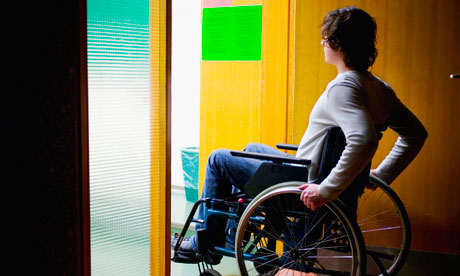
A Papworth Trust survey is the latest to reveal grave concerns at the government’s handling and understanding of disability benefit reforms
Earlier this year, Scope conducted a survey showing that of the proposed £90bn cuts, £9bn will fall upon disabled people. This week’s survey results from disability charity the Papworth Trust add to weight to claims that disabled people are the hardest hit.
The survey aimed to discover how claimants currently use their disability living allowance (DLA) payments, to test public opinion about the proposed personal independence payment (PIP), and to better understand which changes are causing disabled people the most anxiety and distress.
The target of cutting DLA by 20% was perceived as too arbitrary, the product of a government who believed either that costs associated with disability had fallen by 20%, or that 20% of claimants were fraudulent . The Department for Work and Pensions’ (DWP) own figures, in fact, show that only 0.5% of DLA claims are fraudulent.
Many respondents expressed concerns the government is creating a catch 22 situation by the proposed reduction in eligibility. Removing the financial support relied upon for everyday costs directly related to disability would significantly reduce their ability to manage their health conditions – meaning greater reliance on support from the NHS and local authorities in the longer term.
Some 74% of those surveyed said they would be unable to afford basic living costs if their DLA were reduced or withdrawn, and 63% said this reduction would make them more dependent. The three main areas people said they would have to reduce spending on were food, utility bills and specialist transport.
Responding to survey results, the minister for disabled people, Maria Miller, has claimed that DLA is not intended to be spent on food or utility bills, which is curious as the lowest rate of the care component of DLA is awarded to those deemed incapable of preparing a meal for themselves, and intended to support the costs of more expensive pre-prepared vegetables or ready meals.
The minister’s response will add to growing concerns from disabled people’s organisations and charities that not only do the government misunderstand the purpose of DLA, but that the use of statistics to support these cuts has been misleading.
The primary concern about PIP was that it would be unfair. While the Papworth Trust felt that clarification from the government on the reassessment procudre would garner support for the changes, this is likely to be greeted with outrage from disabled people and disabled people’s organisations already concerned that charities claiming to represent us cannot truly do so while still competing for lucrative government contracts.
The report highlights the important issue of how the assessments for different benefits may interact with each other and calls upon the government to clarify this issue. Assessments for Employment Support Allowance relate directly to claimant’s ability to work, whereas currently, assessments for DLA relate to the much wider issues surrounding whether they are mobile and can care for themselves on a day-to-day basis.
Another major concern raised by respondents was the ‘passporting’ nature of DLA, where receipt of DLA at specific rates is used to judge eligibility for other schemes such as the blue badge or council tax benefits. Narrowing the eligibility criteria for DLA, and restricting access to other benefits solely to DLA recipients, will significantly impact those whose disability is not considered severe enough to entitle them to DLA, but still affects their ability to access transport or other services keeping them independent.
There are also worries among sick and disabled people about the way PIP proposes to award points to those who can perform activities using aids and adaptations, for example whether somebody can shower independently only by using shower stools, grab rails and tele-care services to call for help in an emergency. There is no guidance yet on how PIP will consider this in relation to the number of points (and therefore awards) will be granted, which has led to anxiety among claimants that they will be assessed on the basis of theoretically available aids or adaptations.
The flawed assumption that the Disability Discrimination Act 1995 (now Equalities Act) means that accessible transport, services, workplaces aids and adaptations are readily available was also highlighted. The proposed PIP is predicated on an assumption that access is now widespread, but even the assessment centres used by Atos, the company currently contracted to carry out benefits medicals, are regularly reported as being inaccessible.
The issues raised by the Papworth Trust’s survey add weight to the growing evidence from that the sweeping changes being made to sickness and disability benefits are for the benefit of anyone but those vulnerable groups David Cameron’s government promised to protect.
• Kaliya Franklin blogs at Benefit Scrounging Scum

Yes, just like hitler. Target the disabled first. Fascism marches on…